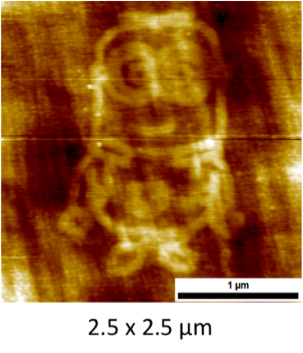Some scientists look at the universe at large to understand the everyday world, but one A&M research group focuses on the exact opposite — the extremely small.
The lab of chemistry professor James Batteas is focused on all things tiny — the nanoscale, or objects that are mere billionths of a meter long. Such a small scale has enormous impact, however, and Batteas and his group investigate how something as simple as the friction between two everyday surfaces can be explained and ultimately controlled.
“Whether you realize it or not, surfaces and interfaces dominate and control just about everything,” Batteas said. “Whether it’s the friction between two surfaces or whether it’s an interaction between some biological molecule and a cell, there’s always an interface involved. What we’re interested in is understanding all those fundamental properties about materials that control their surfaces and interfaces.”
The lab’s current project, funded by the National Science Foundation, aims to understand the atomic scale and how friction really works, said Batteas. The nanoscale can be very difficult to visualize and even harder to manipulate however, and Batteas needed a way to easily convey these ideas in a fun manner. He found the perfect method by challenging the new undergraduate researchers in his lab to sketch out tiny, fanciful drawings such as the A&M logo and even minion characters from the 2010 animated film “Despicable Me.”
“That’s part of what this project developed out of, trying to understand those processes,” Batteas said. “So atomic force microscopy allows us to actually measure them directly on the atomic scale, which is the basis of why we developed this demo.”
The process Batteas’ lab uses to manipulate atoms and molecules on the nanoscale is called “atomic force microscopy.” Atomic force microscopy works by using a microscopic tip that probes a surface. Sketching super-tiny images of things such may seem trivial, but it is also used as practice to prepare new researchers for the lab’s scientific investigations.
“With this particular experiment, when you apply a voltage between the tip and the sample, water condensation between the tip allows the surface to get oxidized as you convert silicon to silicon dioxide, right at the tip,” said Meagan Elinski, chemistry graduate
student, on making images on the nanoscale. “So you can draw very precise patterns.”
Alison Pawlicki, chemistry graduate student, mentored the visiting undergraduate researcher who originally drew the minions. Pawlicki said drawing characters and shapes for fun on the nanoscale serves as stepping stones to get new researchers acquainted with the experiment before they move on to more intensive research.
“It wasn’t anything particular about this minion pattern — we generally make square features, where we trap molecules in domains on the surface,” said Pawlicki. It works a little bit differently than this oxidation process, but it was to introduce our NSF Research Experience for Undergraduates ‘student about using the atomic force microscope to manipulate atoms at the nanoscale and also to introduce her to another method versus the method that we would use later.”
Pawlicki said the lab’s work in nanografting is similar to atomic force microscopy. However, Pawlicki said the former makes depressions in the nanoscale, while the latter is additive and makes something like a mountain on the nanoscale.
“In our other approach we use different types of molecules containing alkyl chains, so we put a layer of these molecules on a surface, and then we have a ‘plow,’ which is the [atomic force microscopy] tip, which plows them away and then we plant, another molecule into the area that we shaved away, and this can be done with any number of different types of molecules,” Pawlicki said.
Batteas said both methods are a way of putting molecules in their place, just with a different kind of reaction.
“In the demonstration that we did here, we’re carrying out a reaction converting silicon to silicon dioxide, so then you have a little strip of silicon dioxide in whatever structure you want,” Batteas said. “In the experiments that Alison is doing, she works with replacing one molecule with another, but again, that only occurs where the AFM tip is.”
Batteas said this particular experiment will be used again this summer during the Youth Adventure Program in which 12 seventh-to-10th graders will come spend a week learning about nanoscience.
“We’ll be using the tool to teach students how you build nanoscale structures,” Batteas said. “The goal of many of these things are in the direction of what’s called nanomanufacturing, and that’s viewed as a next step in the technological revolution.”
Chemistry lab relies on small details for big research
April 6, 2016

Photo by PROVIDED
Nanoscale
Donate to The Battalion
Your donation will support the student journalists of Texas A&M University - College Station. Your contribution will allow us to purchase equipment and cover our annual website hosting costs.






















